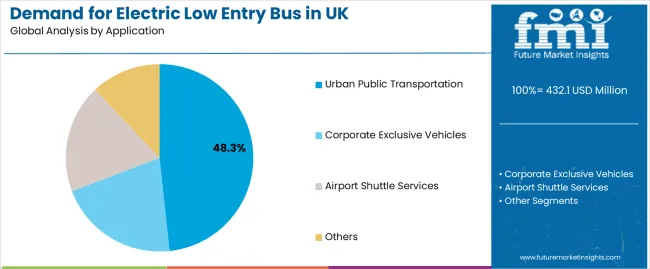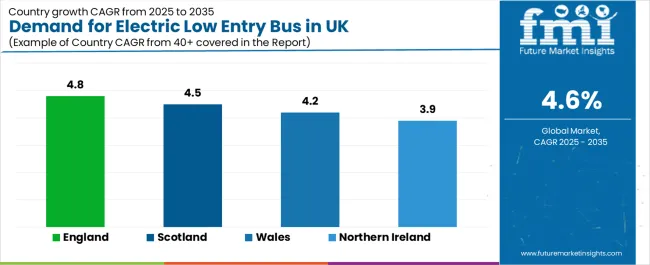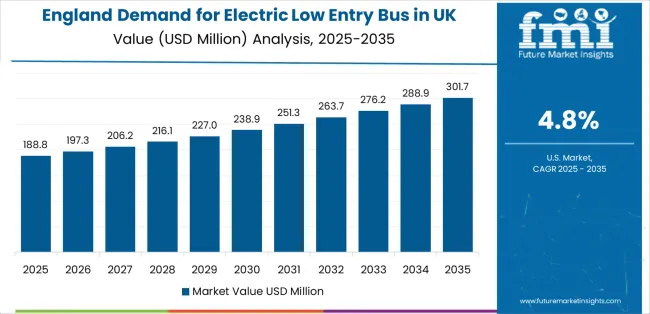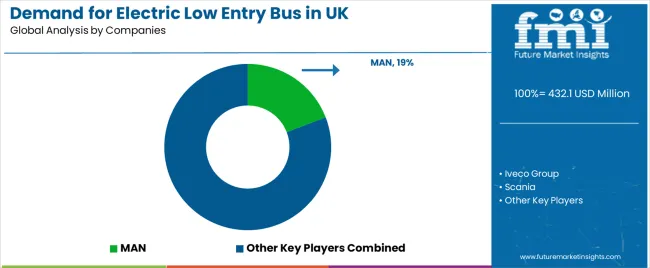The demand for electric low entry bus in UK is projected to grow from USD 432.1 million in 2025 to approximately USD 677.5 million by 2035, recording an absolute increase of USD 242.7 million over the forecast period. This translates into total growth of 56.2%, with demand forecast to expand at a compound annual growth rate (CAGR) of 4.6% between 2025 and 2035. Transit authorities are increasingly prioritizing electric systems that ensure predictable operation, reduced emissions, and compatibility with established urban transport routes. Electric low entry buses support these requirements by offering accessible boarding layouts and consistent operational behavior aligned with modern mobility expectations. The need to meet environmental regulations across metropolitan regions reinforces adoption, with operators relying on electric fleets to meet compliance targets and improve service quality on high-volume routes.
Fleet operators value electric low entry platforms for their integration compatibility with charging infrastructure, performance monitoring systems, and fleet management technologies. These capabilities enable improved operational oversight and predictable service outcomes across urban networks. Public transport operators are adopting electric vehicles that deliver strong reliability and minimal service disruption, especially in city environments where regulated emission thresholds drive decisions on fleet replacement and system upgrades. Environmental policies and transport quality programs continue to shape the operational landscape, encouraging investment in proven electric bus technologies supplied by manufacturers with recognized expertise in zero-emission systems. Transit authorities and fleet operators are expanding electrification initiatives to reinforce long-term operational stability, improve passenger accessibility, and address environmental performance expectations across UK transport corridors.

Between 2025 and 2030, demand is projected to expand from USD 432.1 million to USD 538.3 million, representing a 43.8% increase in total forecast growth for the decade. This phase of growth will be shaped by rising public transport modernization initiatives across the UK, particularly in metropolitan areas where emission reduction targets and accessibility compliance requirements are accelerating electric low entry bus deployment. The increasing integration of pure electric systems in urban applications and the growing adoption of advanced charging infrastructure continue to drive demand. Transit authorities are expanding their electrification capabilities to address the growing complexity of modern emission standards and regulatory specifications, with UK operations leading investments in comprehensive electric bus networks.
From 2030 to 2035, demand is forecast to grow from USD 538.3 million to USD 677.5 million, adding another USD 136.5 million, which constitutes 56.2% of the overall ten-year expansion. This period is expected to be characterized by the expansion of corporate transportation applications, the integration of intelligent fleet management systems and performance-monitoring networks, and the development of specialized bus configurations for different urban applications. The growing adoption of premium electric vehicle technologies and enhanced accessibility requirements, particularly in England and Scotland, will drive demand for more sophisticated transportation systems and specialized vehicle formulations.
Between 2020 and 2025, electric low-entry bus demand in the UK experienced steady expansion, driven by increasing environmental awareness in transportation sectors and growing recognition of zero-emission benefits for urban mobility enhancement and air quality improvement. The sector developed as transit operators and transportation companies, especially in major metropolitan regions, recognized the need for proven electrification solutions and reliable emission management to meet operational targets while complying with environmental regulations and accessibility requirements. Equipment suppliers and bus manufacturers began emphasizing proper performance optimization and system integration to maintain operational efficiency and commercial viability.
| Metric | Value |
|---|---|
| UK Electric Low Entry Bus Sales Value (2025) | USD 432.1 million |
| UK Electric Low Entry Bus Forecast Value (2035) | USD 677.5 million |
| UK Electric Low Entry Bus Forecast CAGR (2025-2035) | 4.6% |
Demand expansion is being supported by the accelerating emphasis on urban transport electrification and emission reduction optimization nationwide, with the UK maintaining its position as a public transportation innovation and environmental compliance leadership region, and the corresponding need for effective zero-emission systems for urban mobility, accessibility enhancement, and transportation reliability integration. Modern transit operators rely on electric low entry bus technologies to ensure operational competitiveness, regulatory compliance, and optimal pathway achievement toward emission-focused transportation operations. Advanced transport requirements necessitate comprehensive electric solutions including specialized vehicle processing, accessibility capabilities, and environmental enhancement infrastructure to address diverse application needs and performance specifications.
The growing emphasis on smart city development and increasing national and regional-level environmental regulations, particularly emission reduction commitments across the UK, are driving demand for zero-emission systems from proven bus suppliers with appropriate electrification expertise and quality management capabilities. Public transport companies and fleet operators are increasingly investing in electric vehicle sourcing and integrated mobility solutions to enhance operational profiles, access transportation optimization trends, and demonstrate technology leadership in competitive market environments. Environmental policies and accessibility compliance requirements are establishing standardized electrification pathways that require zero-emission systems and performance assurance, with UK transportation operations often pioneering large-scale implementation of advanced electric bus technologies.
The electric low entry bus demand in the UK is positioned for consistent expansion, growing from USD 432.1 million in 2025 to USD 674.8 million by 2035, reflecting a 4.6% CAGR. Rising adoption of zero-emission transportation systems in urban transit, corporate shuttle services, and specialized mobility operations is driving growth as operators seek high-performance electric solutions that maximize environmental effectiveness and comply with stringent accessibility standards. Additionally, demand from airport shuttle services and corporate transportation applications strengthens opportunities for both specialized configurations and automated fleet management solutions.
Manufacturers focusing on pure electric configurations, intelligent charging systems, and fleet integration capabilities stand to gain from evolving transportation standards and customer expectations for emission reduction, reliability, and accessibility optimization.
Transit authorities face increasing demands for emission-free transportation environments in premium service operations. Electric low entry bus enables precise accessibility compliance and environmental enhancement without compromising passenger capacity. Solutions targeting premium transit operators, metropolitan transport facilities, and specialized mobility operations can achieve strong adoption rates through emission improvements and regulatory compliance. Estimated revenue opportunity: USD 67.8-101.7 million.
The growth in corporate shuttle services, airport transportation, and executive mobility creates robust demand for electric low entry bus ensuring reliable zero-emission performance in commercial transportation processes. Manufacturers offering accessibility solutions for corporate transportation can build relationships with fleet operators and service providers. Estimated revenue opportunity: USD 47.2-70.8 million.
Transit operators are increasingly adopting automated fleet systems for consistent emission performance. Collaborations with technology manufacturers for integrated transportation solutions can unlock large-volume supply contracts and long-term partnerships in precision mobility applications. Estimated revenue opportunity: USD 42.6-63.9 million.
Environmental regulations and performance requirements are driving preference for pure electric bus systems with enhanced accessibility characteristics. Suppliers offering high-performance electric configurations with superior emission effectiveness can differentiate offerings and attract environmentally-conscious operators. Estimated revenue opportunity: USD 54.1-81.2 million.
Critical transportation applications require specialized buses with exceptional accessibility properties and enhanced emission capabilities. Manufacturers investing in premium configuration development can secure advantages in serving quality-critical urban transport applications. Estimated revenue opportunity: USD 40.3-60.5 million.
Comprehensive service networks offering installation, maintenance, and fleet optimization support create recurring revenue opportunities. Companies building strong technical support capabilities can capture ongoing relationships and enhance customer satisfaction across transit and transportation facilities. Estimated revenue opportunity: USD 31.2-46.8 million.
Demand is segmented by type, application, and region. By type, sales are divided into pure electric, hybrid, fuel cell, and other configurations. In terms of application, sales are segmented into urban public transportation, corporate exclusive vehicles, airport shuttle services, and others. Regionally, demand is divided into England, Scotland, Wales, and Northern Ireland, with England representing a key growth and innovation hub for electric low entry bus technologies.

The pure electric segment is projected to account for 59.7% of UK electric low entry bus demand in 2025, making it the leading type category across the sector. This dominance reflects the emission compatibility and operational reliability of pure electric transportation systems for existing urban transit facilities and transportation applications where zero-emission performance is optimized through proven electric technologies. In the UK, where substantial public transportation infrastructure requires electrification integration without complete system replacement, pure electric systems provide practical pathways for emission enhancement while maintaining operational continuity. Continuous innovations are improving battery effectiveness, charging compatibility characteristics, and system integration parameters, enabling operators to achieve high performance standards while minimizing operational disruption. The segment's strong position is reinforced by the extensive existing transportation infrastructure requiring electric adoption and growing availability of pure electric system suppliers with proven commercial experience.

Urban public transportation applications are expected to represent 48.3% of UK electric low entry bus demand in 2025, highlighting the critical importance of urban mobility requiring specialized zero-emission solutions. Urban transit facilities including metropolitan transportation, regional services, specialized operations, and commercial routes generate consistent demand for electric systems that are technically and economically favorable for transportation applications. The segment benefits from emission characteristics that often provide superior environmental performance compared to conventional transportation alternatives, reducing operational complexity and costs. Urban public transportation also accesses enhanced service quality through emission positioning that improve operational reliability and passenger appeal. In the UK, where urban transport innovation represents substantial portions of transportation infrastructure development, zero-emission deployment requires electric low entry bus integration across diverse urban operations. In England and Scotland regions, where urban transport concentrations are significant, electric low entry bus demand is elevated by emphasis on maintaining operational excellence while achieving emission optimization targets.
UK electric low entry bus demand is advancing steadily due to increasing public transport electrification and growing recognition of zero-emission necessity for transportation development, with England region serving as a key driver of innovation and application development. The sector faces challenges including competition from alternative propulsion technologies, need for specialized charging infrastructure development, and ongoing concerns regarding system integration complexity and cost considerations. National environmental guidelines and regional-level transportation initiatives, particularly emission reduction programs in England and Scotland regions, continue to influence electric vehicle selection and deployment timelines.
The enhancement of emission reduction regulations, gaining particular significance through transportation quality guidelines and environmental campaigns, is enabling bus suppliers to achieve differentiation without prohibitive development costs, providing predictable demand patterns through operational requirements and environmental preferences. Enhanced emission standards offering substantial opportunities for zero-emission systems and transportation applications provide foundational dynamics while allowing suppliers to secure operational agreements and fleet partnerships. These trends are particularly valuable for first-mover suppliers and premium electric development that require substantial technology investments without immediate cost advantages.
Modern bus suppliers and transit operators are establishing advanced zero-emission networks and centralized fleet management facilities that improve operational efficiency through transportation standardization and economies of scale. Integration of intelligent charging systems, real-time performance monitoring, and coordinated fleet management enables more efficient transportation operation across multiple service sources. Advanced transportation concepts also support next-generation mobility applications including specialized urban transport integration, technology cluster optimization, and regional fleet supply networks that optimize system-level economics while enabling comprehensive zero-emission coverage across transportation regions, with UK developments increasingly adopting collaborative fleet models to reduce individual operator costs and accelerate deployment.

| Region | CAGR (2025-2035) |
|---|---|
| England | 4.8% |
| Scotland | 4.5% |
| Wales | 4.2% |
| Northern Ireland | 3.9% |
The UK electric low entry bus demand is witnessing consistent growth, supported by rising public transport electrification, expanding zero-emission requirements, and the deployment of advanced electric technologies across regions. England leads the nation with a 4.8% CAGR, reflecting progressive transportation trends, substantial urban mobility innovation, and early adoption of premium electric systems. Scotland follows with a 4.5% CAGR, driven by extensive public transport infrastructure, favorable technology demographics, and concentration of transportation operations that enhance application development. Wales grows at 4.2%, as transport modernization and technology efficiency opportunities increasingly drive electric deployment. Northern Ireland demonstrates growth at 3.9%, supported by expanding public transport facilities and regional transportation initiatives.

Demand for electric low entry bus in England is projected to exhibit exceptional growth with a CAGR of 4.8% through 2035, driven by progressive public transport preferences, substantial technology development creating premium electric opportunities, and concentration of innovation across London and surrounding regions. As the dominant region with extensive public transportation infrastructure and environmentally-focused operational policies, England's emphasis on comprehensive transportation excellence and technology leadership is creating significant demand for advanced electric low entry bus systems with proven performance and reliable application potential. Major transit operators and bus suppliers are establishing comprehensive electrification development programs to support technology innovation and premium zero-emission deployment across diverse applications.
Demand for electric low entry bus in Scotland is expanding at a CAGR of 4.5%, supported by extensive public transport facilities including metropolitan services, regional operations, and transportation establishments generating concentrated demand favorable for zero-emission systems. The region's operational characteristics, featuring substantial urban transport operations and environmental requirements ideal for electric integration, provide natural advantages. Transportation expertise concentrated in Glasgow, Edinburgh, and regional service corridors facilitates application development and operational management. Bus suppliers and operators are implementing comprehensive electrification strategies to serve expanding environmentally-focused requirements throughout Scotland.
Demand for electric low entry bus in Wales is growing at a CAGR of 4.2%, driven by substantial transportation facilities from urban transit operations, regional services, and local transport requiring zero-emission pathways. The region's transport base, supporting critical urban operations, is increasingly adopting electric technologies to maintain competitiveness while meeting environmental expectations. Operators and bus suppliers are investing in electrification integration systems and regional supply infrastructure to address growing emission management requirements.
Demand for electric low entry bus in Northern Ireland is advancing at a CAGR of 3.9%, supported by expanding public transport facilities, regional technology development including specialized applications, and growing emphasis on zero-emission solutions across the region. Transportation modernization and public transport facility expansion are driving consideration of electric systems as operational enhancement pathways. Transit companies and bus suppliers are developing regional capabilities to support emerging electrification deployment requirements.

UK electric low entry bus demand is defined by competition among specialized electric vehicle manufacturers, transportation technology companies, and zero-emission system providers, with major commercial vehicle corporations maintaining significant influence through supply chain resources and technology development capabilities. Companies are investing in electric technology advancement, supply chain optimization, distribution network structures, and comprehensive application services to deliver effective, reliable, and scalable zero-emission solutions across UK public transportation and commercial vehicle applications. Strategic partnerships, technology infrastructure development, and first-mover application execution are central to strengthening competitive positioning and presence across urban transit, corporate transportation, and specialized mobility applications.
MAN, internationally recognized commercial vehicle leader, leads with 19.2% share, offering comprehensive electric low entry bus supply including manufacturing, technology, and distribution services with focus on urban transportation applications, performance reliability, and cost optimization across UK operations. Iveco Group, operating with extensive UK distribution, provides integrated zero-emission solutions leveraging electric expertise, quality assurance development, and precision manufacturing capabilities.
Scania delivers full-service electric low entry bus processing including vehicle technology, performance testing, and supply management serving UK and European transportation projects. Volvo emphasizes comprehensive transportation solutions with integrated zero-emission systems, quality control, and distribution capabilities leveraging transit expertise. Sunlong Bus offers electric low entry bus application development and quality assurance operations for transportation and mobility applications across UK operations.
|
Item |
Value |
|---|---|
| Quantitative Units | USD 677.5 million |
| Type | Pure Electric, Hybrid, Fuel Cell, Other Configurations |
| Application | Urban Public Transportation, Corporate Exclusive Vehicles, Airport Shuttle Services, Others |
| Regions Covered | England, Scotland, Wales, Northern Ireland |
| Key Companies Profiled | MAN, Iveco Group, Scania, Volvo, Sunlong Bus, Xiamen King Long Motor Group, Shanghai Wanxiang Automobile Factory, Anhui Ankai Automobile Co., Ltd, BYD, CRRC Zhuzhou Locomotive Co., Ltd |
| Additional Attributes | Sales by type and application segment, regional demand trends across England, Scotland, Wales, and Northern Ireland, competitive landscape with established commercial vehicle suppliers and specialized electric manufacturers, transit operator preferences for pure electric versus hybrid technologies, integration with transportation electrification programs and zero-emission policies particularly advanced in England region |
The global demand for electric low entry bus in UK is estimated to be valued at USD 432.1 million in 2025.
The market size for the demand for electric low entry bus in UK is projected to reach USD 677.5 million by 2035.
The demand for electric low entry bus in UK is expected to grow at a 4.6% CAGR between 2025 and 2035.
The key product types in demand for electric low entry bus in UK are pure electric, hybrid, fuel cell and other configurations.
In terms of application, urban public transportation segment to command 48.3% share in the demand for electric low entry bus in UK in 2025.






Our Research Products

The "Full Research Suite" delivers actionable market intel, deep dives on markets or technologies, so clients act faster, cut risk, and unlock growth.

The Leaderboard benchmarks and ranks top vendors, classifying them as Established Leaders, Leading Challengers, or Disruptors & Challengers.

Locates where complements amplify value and substitutes erode it, forecasting net impact by horizon

We deliver granular, decision-grade intel: market sizing, 5-year forecasts, pricing, adoption, usage, revenue, and operational KPIs—plus competitor tracking, regulation, and value chains—across 60 countries broadly.

Spot the shifts before they hit your P&L. We track inflection points, adoption curves, pricing moves, and ecosystem plays to show where demand is heading, why it is changing, and what to do next across high-growth markets and disruptive tech

Real-time reads of user behavior. We track shifting priorities, perceptions of today’s and next-gen services, and provider experience, then pace how fast tech moves from trial to adoption, blending buyer, consumer, and channel inputs with social signals (#WhySwitch, #UX).

Partner with our analyst team to build a custom report designed around your business priorities. From analysing market trends to assessing competitors or crafting bespoke datasets, we tailor insights to your needs.
Supplier Intelligence
Discovery & Profiling
Capacity & Footprint
Performance & Risk
Compliance & Governance
Commercial Readiness
Who Supplies Whom
Scorecards & Shortlists
Playbooks & Docs
Category Intelligence
Definition & Scope
Demand & Use Cases
Cost Drivers
Market Structure
Supply Chain Map
Trade & Policy
Operating Norms
Deliverables
Buyer Intelligence
Account Basics
Spend & Scope
Procurement Model
Vendor Requirements
Terms & Policies
Entry Strategy
Pain Points & Triggers
Outputs
Pricing Analysis
Benchmarks
Trends
Should-Cost
Indexation
Landed Cost
Commercial Terms
Deliverables
Brand Analysis
Positioning & Value Prop
Share & Presence
Customer Evidence
Go-to-Market
Digital & Reputation
Compliance & Trust
KPIs & Gaps
Outputs
Full Research Suite comprises of:
Market outlook & trends analysis
Interviews & case studies
Strategic recommendations
Vendor profiles & capabilities analysis
5-year forecasts
8 regions and 60+ country-level data splits
Market segment data splits
12 months of continuous data updates
DELIVERED AS:
PDF EXCEL ONLINE
Demand Signal Repository Solutions Market Size and Share Forecast Outlook 2025 to 2035
Demand Side Management Market Size and Share Forecast Outlook 2025 to 2035
Demand Response Market Analysis - Size, Share, and Forecast Outlook 2025 to 2035
North America Shipping Supplies Market Trends – Innovations & Growth 2024-2034
Demand of Kozani Saffron in Greece Analysis - Size, Share & Forecast 2025 to 2035
Demand of No-acid Whey Strained Dairy Processing Concepts in European Union Size and Share Forecast Outlook 2025 to 2035
Demand for Bronte Pistachio in Italy Analysis - Size, Share & Forecast 2025 to 2035
Demand and Trend Analysis of Gaming Monitor in Western Europe Size and Share Forecast Outlook 2025 to 2035
Demand and Trend Analysis of Gaming Monitor in Japan Size and Share Forecast Outlook 2025 to 2035
Demand and Trend Analysis of Gaming Monitor in Korea Size and Share Forecast Outlook 2025 to 2035
Glycine Soja (Soybean) Seed Extract Market Size and Share Forecast Outlook 2025 to 2035
Demand and Trend Analysis of Yeast in Japan - Size, Share, and Forecast Outlook 2025 to 2035
Demand and Trends Analysis of Stevia in Japan Size and Share Forecast Outlook 2025 to 2035
Demand of Pistachio-based desserts & ingredients in France Analysis - Size, Share & Forecast 2025 to 2035
Japan Women’s Intimate Care Market Trends – Growth & Forecast 2024-2034
Western Europe Men’s Skincare Market Analysis – Forecast 2023-2033
Demand and Trend Analysis of Fabric Stain Remover in Korea Size and Share Forecast Outlook 2025 to 2035
Demand and Sales Analysis of Paper Cup in Japan Size and Share Forecast Outlook 2025 to 2035
Demand and Sales Analysis of Paper Cup in Korea Size and Share Forecast Outlook 2025 to 2035
Demand and Sales Analysis of Paper Cup in Western Europe Size and Share Forecast Outlook 2025 to 2035

Thank you!
You will receive an email from our Business Development Manager. Please be sure to check your SPAM/JUNK folder too.
Chat With
MaRIA